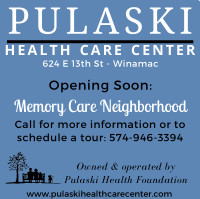COVID tests kits are available from the Pulaski County Health Department and Pulaski Memorial Hospital clinics.
To obtain a COVID vaccination or booster shots, consult with your healthcare provider or pharmacy. Or visit the Indiana Department of Health website page on Where to Find a COVID-19 Vaccine.
|
Pulaski County Area The breakdown by area zip codes: (Indiana - 55.4%)
Source: IDH Vaccine Dashboard |
A total of 3,866,141 individuals have completed the primary series of vaccines in Indiana, or a total of 55.4% of the state population. A total of 989,526 Hoosiers are up-to-date with COVID-19 vaccines and boosters. (Indiana Dashboard vaccine data reflect the Centers for Disease Control and Prevention's definition of up-to-date, which now includes updated bivalent doses.)
In Pulaski County there are 5,780 residents who have completed the primary series of vaccines. A total of 1,311 county residents are up-to-date with booster shots. Pulaski County population 12,339 (2021)
(The IDH COVID Dashboard is updated every Wednesday.)
CDC Hospital Admission Levels
The CDC has replaced COVID-19 Community Levels with COVID-19 hospital admission levels to guide prevention decisions. Changes based on:
- MMWR: COVID-19 Surveillance After Expiration of the Public Health Emergency Declaration ― United States, May 11, 2023
- MMWR: Correlations and Timeliness of COVID-19 Surveillance Data Sources and Indicators ― United States, October 1, 2020–March 22, 2023
What You Need to Know
- COVID-19 hospital admission levels can help individuals and communities decide which prevention actions they can take based on the latest information.
- For each level, CDC recommends actions you can take to help you protect yourself and others from severe impacts of COVID-19.
Many people in the United States have some protection, or immunity, against COVID-19 due to vaccination, previous infection, or both. This immunity, combined with the availability of tests and treatments, has greatly reduced the risk of severe illness, hospitalization, and death from COVID-19 for many people.
At the same time, some people—such as those who are older, are immunocompromised, have certain disabilities, or have certain underlying health conditions—continue to be at higher risk for serious illness. Learn more about the factors that can affect your risk of getting very sick from COVID-19 to better understand how COVID-19 could affect you and others around you.
The CDC reports that last week COVID-19 hospital admissions in the U.S. totaled 18,139, which is down 6.0 percent from the previous report. COVID-19 hospital admissions per 100,000 population is 5.46. The trend in COVID deaths nationally was up 3.8 percent in the most recent report (data through Sept. 30).
| County | New hospital admissions of confirmed COVID-19 past week | % change from prior week | New COVD-19 hospital admissions rate per 100,000 population in past week |
| Pulaski | 17 | 41.7% | 4.9 |
| Starke | 5 | 66.7 | 3.8 |
| Marshall | 17 | 41.7% | 4.9 |
| Fulton | 17 | 41.7% | 4.9 |
| Cass | 6 | 500% | 4.4 |
| White | 12 | -7.7% | 4.3 |
| Jasper | 23 | 0% | 3.3 |
The CDC hospital admission level continues at the "Low" designation for Pulaski County for the last reporting period. In the surrounding area, neighboring counties Starke, Marshall, Fulton, Cass, White and Jasper are also all at the Low level. Also, all of Indiana is at the Low level.
Individual-Level Prevention Steps you can take based on your COVID-19 Hospital Admission Level
- Stay up to date on vaccination.
- Maintain ventilation improvements.
- Avoid contact with people who have suspected or confirmed COVID-19.
- Follow recommendations for isolation if you have suspected or confirmed COVID-19.
- Follow the recommendations for what to do if you are exposed to someone with COVID-19.
- If you are at high risk of getting very sick, talk with a healthcare provider about additional prevention actions.
Community-Level Prevention Strategies
- Promote equitable access to vaccination, testing, masks and respirators, treatment and prevention medications, community outreach, and support services.
- Ensure access to testing, including through point-of-care and at-home tests for all people.
- Maintain ventilation improvements.
- Provide communications and messaging to encourage isolation among people who test positive.







